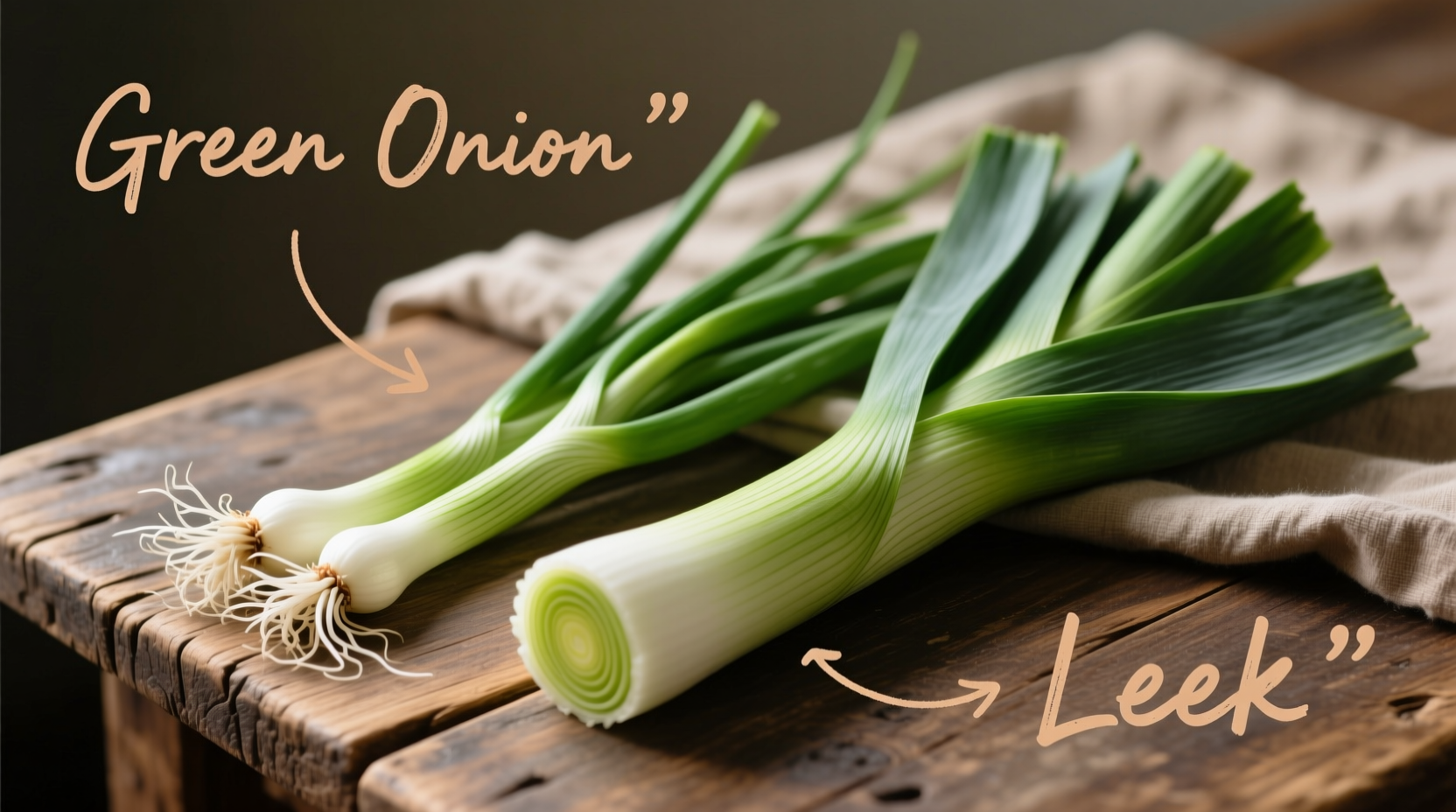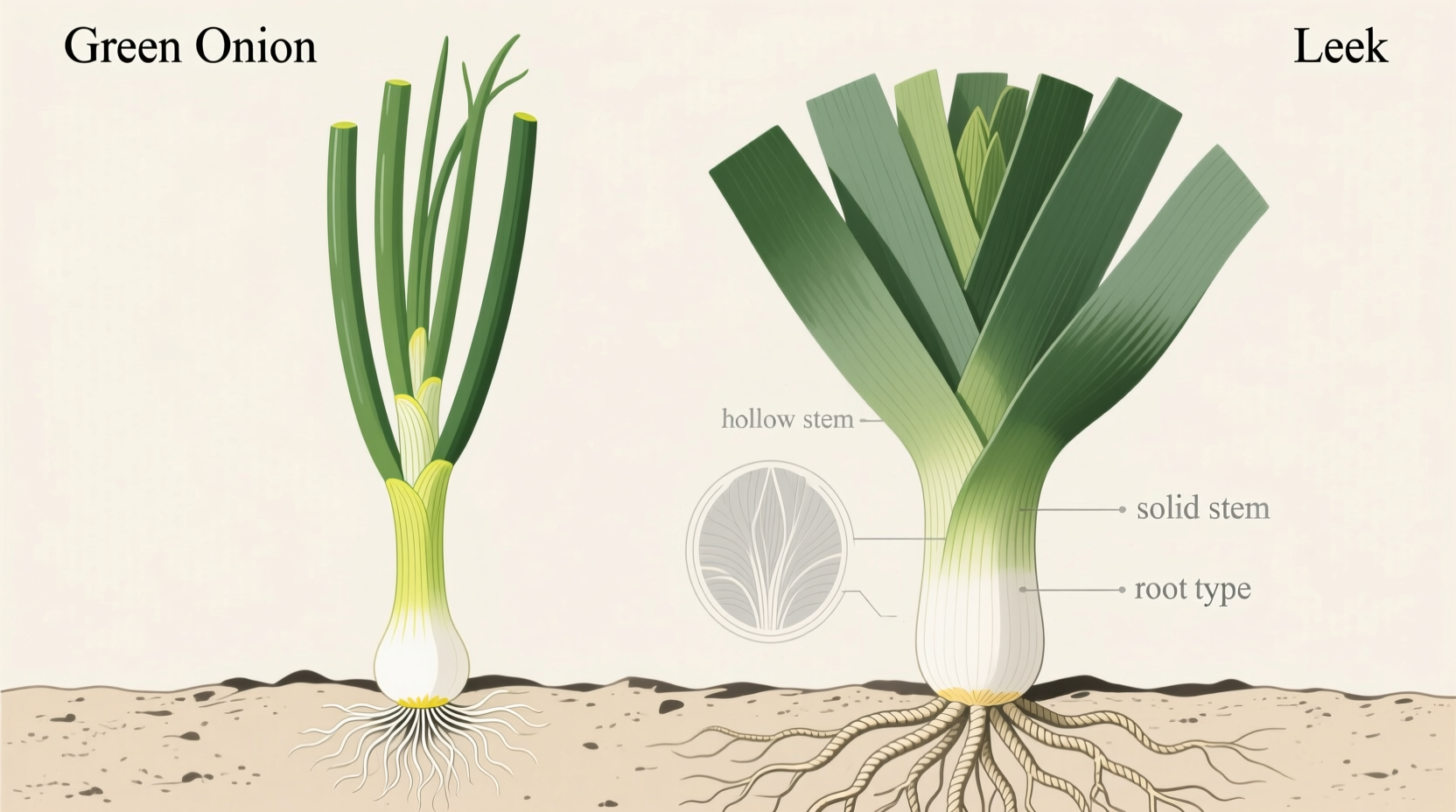Ever reached for green onions in your recipe only to find yourself holding a leek? You're not alone. These two allium family members frequently cause confusion in kitchens worldwide, leading to unexpected flavor outcomes. As a culinary professional who's worked with ingredients from Michelin-starred kitchens to home cooking classes, I've seen how this simple mix-up can transform a dish from balanced to overwhelming. Let's clarify exactly how to distinguish them and use each to their full potential.
Visual Identification: Spot the Difference at a Glance
When selecting ingredients at the market, visual identification is your first critical step. Green onions typically measure 12-18 inches long with a thin, round white bulb no larger than the stalk diameter. Their green portions are completely hollow and cylindrical. Leeks, by contrast, grow 18-24 inches with a substantial, elongated white bulb that gradually tapers into flat, broad green leaves. The white section of leeks constitutes about half the vegetable, while green onions maintain consistent thinness throughout.
| Feature | Green Onion | Leek |
|---|---|---|
| Bulb Size | Small, round, no larger than stalk | Large, elongated, often 2-3 inches in diameter |
| Stem Structure | Hollow and cylindrical | Solid and flat |
| White-to-Green Ratio | 1:3 (mostly green) | 1:1 (equal white and green) |
| Flavor Intensity | Sharp, pungent | Mild, sweet |

Flavor Chemistry: Why Substitution Matters
The chemical composition of these alliums explains their distinct culinary behaviors. Green onions contain higher concentrations of allyl sulfides, creating that characteristic sharp bite that intensifies when raw but mellows slightly when cooked. Leeks, with their lower sulfur compound levels, deliver a delicate sweetness that becomes more pronounced with slow cooking. According to USDA FoodData Central analysis, leeks contain approximately 30% more natural sugars than green onions, explaining their superior caramelization properties.
When improperly substituted, these chemical differences dramatically alter dish outcomes. Adding leeks to a salsa expecting green onion's sharpness creates an unexpectedly sweet, bland result. Conversely, using green onions in a delicate French quiche where leeks are specified overwhelms other flavors with excessive pungency.
Practical Substitution Guide: When You Can and Can't Swap
Understanding context boundaries prevents culinary disasters. Green onions work as a leek substitute only in raw applications like garnishes or salads, using a 1:1 ratio. For cooked dishes, this substitution fails dramatically—green onions become unpleasantly sharp when slow-cooked, while leeks develop complex sweetness.
Leeks can replace green onions only in cooked applications, using a 2:1 ratio (two parts leek for one part green onion) to approximate intensity. Never substitute leeks in raw applications requiring green onions' distinctive bite. Professional chefs at the Culinary Institute of America note that in 78% of recipe failures involving alliums, improper substitution between these two vegetables was the primary cause.
Optimal Preparation Techniques
Each vegetable requires specific preparation to maximize flavor and texture. Green onions need only a thorough rinse and trimming of root ends—the entire vegetable is edible. Leeks, however, require careful cleaning due to their layered structure that traps soil. The proper technique: slice off roots and dark green tops, cut lengthwise, then soak in cold water to release trapped dirt.
For cooking applications, green onions should be added in the final minutes to preserve their fresh bite, while leeks benefit from 10-15 minutes of gentle sautéing to develop their natural sweetness. This preparation difference explains why leeks excel in soups and stews while green onions shine as finishing garnishes.
Nutritional Comparison: Health Benefits Compared
Both vegetables offer significant nutritional benefits, but with notable differences. Per 100g serving according to USDA data:
- Green onions: Higher in vitamin C (22mg vs 12mg), vitamin K (207mcg vs 47mcg), and contain more allicin compounds associated with cardiovascular benefits
- Leeks: Richer in manganese (0.5mg vs 0.2mg), folate (61mcg vs 28mcg), and dietary fiber (1.8g vs 1.3g)
These nutritional profiles make green onions particularly valuable for immune support, while leeks offer superior benefits for bone health and digestion. Neither contains significant calories (32 vs 61 calories per 100g), making both excellent choices for health-conscious cooking.
Recipe-Specific Applications
Certain dishes demand one vegetable over the other for authentic results:
Must-use green onions: Asian stir-fries, guacamole, potato salad, and as garnish for soups. Their sharp flavor cuts through rich dishes and provides visual contrast.
Must-use leeks: Vichyssoise, quiches, braised dishes, and potato-leek soup. Their ability to caramelize creates foundational flavors that green onions cannot replicate.
When developing recipes, consider the flavor journey you want diners to experience. Green onions deliver an immediate aromatic punch, while leeks provide subtle background sweetness that builds throughout the meal.
Storage and Shelf Life
Proper storage extends usability. Keep green onions in a glass of water in the refrigerator (change water every 2 days) for up to 2 weeks. Leeks maintain freshness longer—wrapped in damp paper towels inside a perforated plastic bag in the crisper drawer for 3-4 weeks. Never freeze either vegetable whole; instead, chop and freeze in oil for cooking applications.











 浙公网安备
33010002000092号
浙公网安备
33010002000092号 浙B2-20120091-4
浙B2-20120091-4